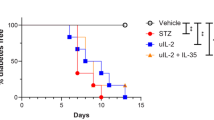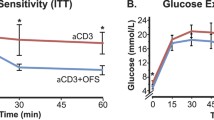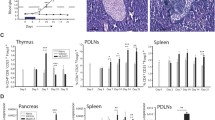Abstract
Cytokine-inducers prevent insulin-dependent diabetes mellitus (IDDM) in animal models. We extended this therapy to non-insulin-dependent diabetes mellitus (NIDDM), because it was reported that diabetes of KK-Ay mice, a model for NIDDM, was recovered by allogenic bone-marrow transplantation that also prevented IDDM in animal models.
An i.p. or i.v. injection of streptococcal preparation (OK 432) lowered fasting blood glucose (FBG) levels and markedly improved glucose tolerance test (GTT) in KK-Ay mice for more than 32 h regardless of the glucose loading routes (oral, i.v. or i.p.), while an i.v. injection of BCG improved FBG and GTT for more than 4 wks without body weight loss. The improvement of FBG and GTT with OK-432 was brought about in other NIDDM animals, GK rats and Wistar fatty rats. Among various cytokines possibly induced by OK-432 and BCG, IL-1α, TNFα and lymphotoxin significantly improved FBG and GTT in KK-Ay mice, whereas IL-2 and IFNγ did not. There were no differences between the OK-432-treated KK-Ay mice and control in histology of the pancreas, degree of insulin-induced decrease in blood glucose levels, and muscle glycogen synthase activities. As to insulin secretion, there is a tendency that the OK-432-treatment less than 1 week did not affect insulin levels during GTT, whereas the treatment more than 2 weeks increased the insulin levels.
Thus, cytokine-inducers improved FBG and glucose tolerance of NIDDM animals probably via cytokines. The results imply a role of the cytokines in glucose tolerance of NIDDM, although precise immune and metabolic mechanisms remain to be elucidated.
Similar content being viewed by others
References
Eisenbarth GS. Type 1 diabetes mellitus. A chronic autoimmune disease. N Engl J Med 1986; 314: 1360–1368.
Than S, Ishida H, Inaba M, Fukuba Y, Seino Y, Adachi M, Imura H, Ikehara S. Bone marrow transplantation as a strategy for treatment of non-insulin-dependent diabetes mellitus in KK-Ay mice. J Exp Med 1992; 176: 1233–1238.
Kondo K, Nozawa K, Tomida T, Ezaki K. Inbred strains resulting from Japanese mice. Bull Exp Animals 1957; 6: 107–112.
Nakamura M, Yamada K. Studies on a diabetic (KK) strain of the mouse. Diabetologia 1967; 3: 212–221.
Diani AR, Sawada GA, Hannah BA, Jodelis KS, Connell MA, Connell CL, Vidmar TJ, Wyse BM. Analysis of pancreatic islet cells and hormone content in the spontaneously diabetic KK-Ay mouse by morphometry, immunocytochemistry and radioimmunoassay. Wirchows Arch A 1987; 412: 53–61.
Toyota T, Satoh J, Oya K, Shintani S, Okano T. Streptococcal preparation (OK-432) inhibits development of type 1 diabetes in NOD mice. Diabetes 1986; 35: 496–499.
Satoh J, Shintani S, Oya K, Tanaka S, Nobunaga T, Toyota T, Goto Y. Treatment with streptococcal preparation (OK-432) suppresses anti-islet autoimmunity and prevents diabetes in BB rats. Diabetes 1988; 37: 1188–1194.
Satoh J, Seino H, Abo T, Tanaka S, Shintani S, Ohta S, Tamura K, Sawai T, Nobunaga T, Ohteki T, Kumagai K, Toyata T. Recombinant human tumor necrosis factor a suppresses autoimmune diabetes in nonobese diabetic mice. J Clin Invest 1989; 84: 1345–1348.
Satoh J, Seino H, Shintani S, Tanaka S, Ohteki T, Masuda, T, Nobunaga T, Toyota T. Inhibition of type 1 diabetes in BB rats with human tumor necrosis factor α. J Immunol 1990; 145: 1395–1399.
Seino H, Takahashi K, Satoh J, Zhu XP, Sagara M, Masuda, T, Nobunaga T, Funahashi I, Kajikawa T, Toyata T. Prevention of autoimmune diabetes with lymphotoxin in NOD mice. Diabetes 1993; 42: 398–404.
Takahashi K, Satoh J, Seino H, Zhu XP, Sagara M, Masuda, T, Toyota T. Prevention of type 1 diabetes with lymphotoxin in BB rats. Clin Immunol Immunopathol 1993; 69: 318–323.
Goto Y, Kakizaki M. The spontaneous-diabetes rat: A model of non-insulin dependent diabetes mellitus. Proc J Acad 1981; 57: 381–384.
Ikeda H, Shino A, Matsuo T, Iwatsuka H, Suzuoka Z. A new genetically obese-hyperglycemic rat (Wistar fatty). Diabetes 1981; 30: 1045–1050.
Schooley JC, Kullgren B, Allison AC. Inhibition by interleukin-1 of the action of erythropoietin on erythroid precursors and its possible role in the pathogenesis of hypoplastic anaemias. Brit J Haematol 1987; 67: 11–17.
Gaffney EV, Tsai S-C. Lymphocyte-activating and growth-inhibitory activities for several sources of native and recombinant interleukin I. Cancer Res 1986; 46: 3834–3837.
Zhou P, Quackenbush LJ, Zaleski MB.In vitro proliferation of murine spleen cells. Strain variation of proliferative responses induced by recombinant IL-2. Int Arch Allergy App Immunol 1989; 90: 162–168.
Lewis M, Tartaglia LA, Lee A, Bennett GL, Rice GC, Wong GHW, Chen EY, Goeddel DV. Cloning and expression of cDNAs for two distinct murine tumor necrosis factor receptors demonstrate one receptor is species specific. Proc Natl Acad Sci USA 1991; 88: 2830–2834.
Desbunguois B, Aurbach GD. Use of polyethylene glycol to separate free and antibody-bound peptide hormones in radioimmunoassays. J Clin Endocrinol Metab 1971; 33: 732–738.
Thomas JA, Schlender KK, Larner J. A rapid filter paper assay for UDP-glucose-glycogen glucosyltransferase, including an improved biosynthesis of UDP-14C-glucose. Analytical Biochem 1968; 25: 486–499.
Ichimura O, Suzuki S, Sugawara Y, Osawa T. Lymphokines induction by streptococcal preparation OK-432 (picibanil) in mice: Characterization of interleukin 1 (IL-1), interleukin 2 (IL-2) and natural killer cell activating factor (NKAF). In: Hoshino T ed. OK-432. Proceeding of an international symposium held at the 13th International Congress of Chemotherapy, Vienna, September 1983. Amsterdam-Princeton-Geneva-Tokyo:, Excerpta Medica, 1984: 50–72.
Suzuki K, Fukutomi Y, Matsuoka M, Torii K, Hayashi H, Takii T, Oomoto Y, Onozaki K. Differential production of interleukin I (IL-1), IL-6, tumor necrosis factor, and IL-1 receptor antagonist by human monocytes stimulated with Mycobacterium leprae and M. bovis BCG. Int J Lepr Other Mycobact Dis 1993; 61: 609–618.
Villar-Palasi C, Larner J. Insulin treatment and increased UDPG-glycogen transglucosylase activity in muscle. Arch Biochem Biophys 1961; 94: 436–442.
Rosell-Perez M, Villar-Palasi C, Larner J. Studies on UDPG-glycogen transglucosylase. I. Preparation and differentiation of two activities of UDGP-glycogen transglucosylase from rat skeletal muscle. Biochemistry 1962; 1: 763–768.
Watanabe Y, Iwa T. Clinical value of immunotherapy for lung cancer by the streptococcal preparation OK-432. Cancer 1984; 53: 248–253.
McCallum RE, Berry LJ. Effects of endotoxin on gluconeogenesis, glycogen synthesis, and liver glycogen synthase in mice. Infect Immunol 1973; 7: 642–654.
Yamada, K.: Effects of PSK (Krestin) on interleukin production.In: Ishigami J, ed. Recent Advance in Chemotherapy, Anticancer Section 2. Tokyo: Univ. of Tokyo Press, 1985: 876–877.
del Rey A, Besedovsky H. Antidiabetic effects of interleukin 1. Proc Natl Acad Sci USA 1989; 86: 5943–5947.
Comens PG, Wolf BA, Unanue ER, Lacy PE, McDaniel ML. Interleukin I is a potent modulator of insulin secretion from isolated rat islets of Langerhans. Diabetes 1987; 36: 963–970.
Hotamisligil GS, Spiegelman BM. Tumor necrosis factor α: A key component of the obesity-diabetes link. Diabetes 1994; 43: 1271–1278.
Lang CH, Dobrescu C, Bagby GJ. Tumor necrosis factor impairs insulin action on peripheral glucose disposal and hepatic glucose output. Endocrinology 1992; 130: 43–52.
Williams JG, Jurkovich GJ, Hahnel GB, Maier RV. Macrophage priming by interferon gamma: a selective process with potentially harmful effects. J Leukoc Biol 1992; 52: 579–584.
Dinneen S, Gerich J, Rizza R. Carbohydrate metabolism in non-insulin-dependent diabetes mellitus. N Engl J Med 1992; 327: 707–713.
Leahy JL, Bonner-Weir S, Weir GC. Beta cell dysfunction induced by chronic hyperglycemia. Current ideas on mechanism of impaired glucose-induced insulin secretion. Diabetes Care 1992; 15: 442–455.
Hill M, McCallum R. Altered transcriptional regulation of phosphoenolpyruvate carboxykinase in rats following endotoxin treatment. J Clin Invest 1991; 88: 811–816.
Author information
Authors and Affiliations
Rights and permissions
About this article
Cite this article
Zhu, X.P., Satoh, J., Muto, G. et al. Improvement of glucose tolerance with immunomodulators in type 2 diabetic animals. Biotherapy 9, 189–197 (1996). https://doi.org/10.1007/BF02620732
Received:
Accepted:
Issue Date:
DOI: https://doi.org/10.1007/BF02620732




